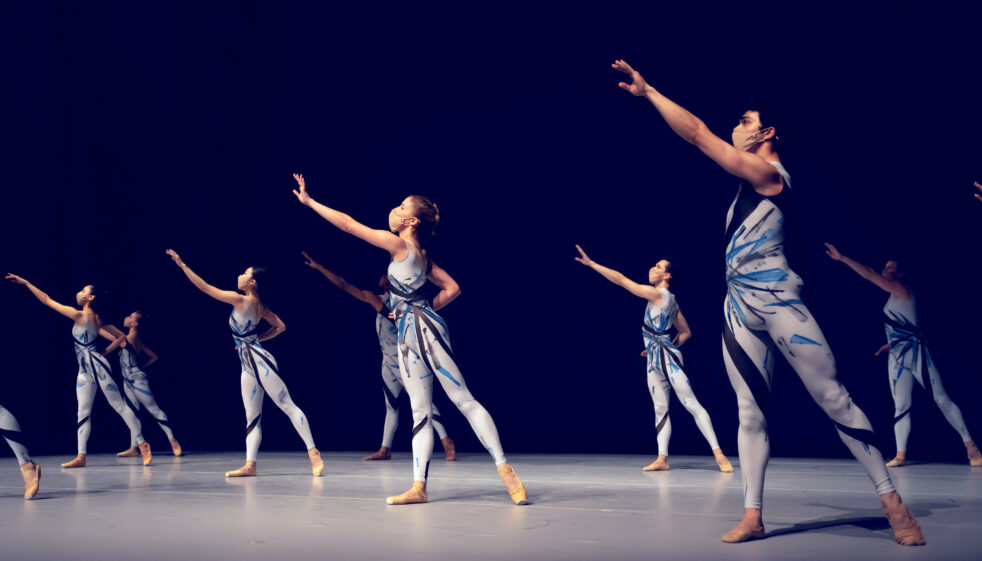On Mar. 19, the Atlanta Ballet took to the stage of the Rialto Center for the Arts at Georgia State University for a second installation of “Silver Linings,” the company’s first live production in over a year.
The highlight of the program was the world premiere of “Pleiades Dances,” a new ballet by Atlanta Ballet Choreographer-in-Residence Claudia Schreier. The ballet, which is composed of 11 vignettes to the music of Takashi Yoshimatsu, features a cast of 12 dancers, all wearing unitards that show off Schreier’s sometimes unconventional shapes. The ballet is playfully pedestrian, relying on shape and movement and the occasional cartwheel rather than anything showy.
“Claudia’s ballets distinguish themselves with a very specific combination of simplicity, youthfulness and nuanced pattern work,” said Atlanta Ballet company dancer Darian Kane, “There’s an incredibly comprehensive understanding of music she disguises into something that looks agile yet at ease while constantly shifting into many patterns.”
The choreography of “Pleiades Dances” is deeply rooted in the complex rhythms of the score, which Yoshimatsu created over the course of his career. Schreier, who says she is a big believer in saving the right music for the right time, had encountered Yoshimatsu’s work many years earlier, and had been waiting for the perfect opportunity. When she started brainstorming the ballet that would become “Pleiades Dances,” she came back to Yoshimatsu’s score.
At the time, Schreier was not sure how much she would have to scale up or down the production, given the uncertainty of the time in which it was created. The episodic format made sense, in case the opportunity to present excerpts arose. Though the ballet eventually became a full-scale ensemble piece, Schreier said that “being able to immerse myself in these gorgeous vignettes at a time that is so heavy and so challenging for so many is a real gift.”
The inspiration for the piece’s choreography depends heavily on Yoshimatsu’s uses of rhythm, tone, and color. “The complexity of the score keeps your attention,” said Schreier, “and engages both the audiences and the dancers as they weave in and out of the music.”
The ballet is also inspired by the titular constellation, Pleiades, and celebrates the simple pleasure of being able to come together and dance together.
“In a time when most of us are not allowed to touch and partner and feel connected in the ways we usually would as ballet dancers, it’s joyful to feel that sense of comradery infused into the dance,” said company member Jackie Nash of the ballet, “We might not be able to hold hands, but Claudia is really encouraging us to engage with each other emotionally, through eye contact and body language.”
“Pleiades Dances” was created 95% virtually, with Schreier Zoom calling into Atlanta where her dancers worked in pre-formed pods. The team had to work through the same difficulties of virtual communication as everyone else, with the added complication that Schreier was setting her work on two separate rooms of ten people each. Because the pods were already set, she couldn’t give any structure to the ballet, but focused only on the movement.
The process involved multiple sessions throughout the day; Schreier would teach one group in the morning, reteach and rework the piece on a different group, and then go back the next morning to start again.
“To me it feels more like a group effort than ever before,” Kane said, “Every person in the room or on screen has to show up ready to work through potential errors in interpretation and be willing to ask more questions.
In that sense, creating this ballet has empowered more communication between dancer and choreographer.” But there were silver linings to the extended rehearsal process. Schreier says that she had the opportunity to explore a different part of herself and her choreography.
The pandemic, for her, offered the chance to regain a sense of calm after the whirlwind of work that made up the preceding year.
“I found a freer sense of movement, gave myself a wider creative berth,” Schreier said, “I had a sense of ‘if not now, when?’ that gave me the opportunity to explore these quirky, more contemporary movements.”
The entire “Silver Linings” program, including “Pleiades Dances,” is available to watch on the Rialto Center’s YouTube channel.
Atlanta Ballet will also perform “Silver Linings” live as part of the Georgia Tech Arts Skyline Series Apr. 30 – May 9.
Tickets are available online at artsgatech.universitytickets.com.
